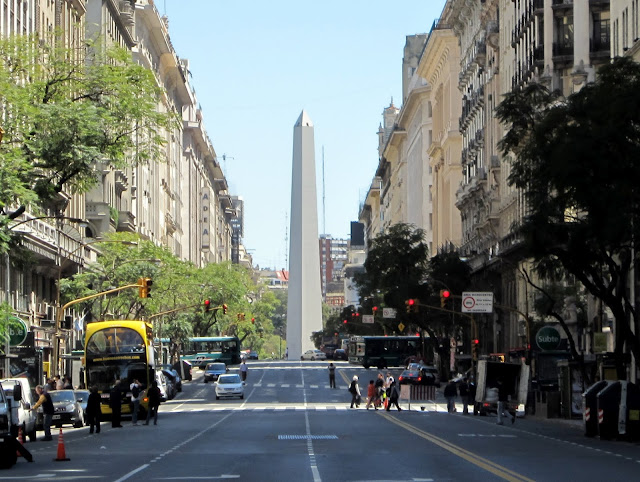It is not really that surprising to learn that Buenos Aires experienced a massive influx of immigrants from Europe in the early 20th century that drove much of the development of the city and nation. The population between 1895 and 1914 nearly doubled and was one of the primary destinations for immigrants coming to the new world, behind the United States. The influx of immigrants from Italy, Spain, and France have especially left a mark on the culture of Argentina, but immigrants came from all over Europe, including Russians, Volga Germans, and, like my grandmother, Scandinavians. As a result, when the city was being planned in the late 19th century and early 20th century, much of the urban planning and ideals were imported directly from Europe. The European monumental metropolis was to be raised in Buenos Aires, their new home.
In many ways, they succeeded. The city is massive and block by block resembles Paris or any other European city. That was the source of my déjà vu, as well as the fact that the cuisine had suddenly become distinctly European. The art nouveau decoration and sensibility that you find in the streets of Paris is here. The subway system clearly echos the belief of the era that all cities of note should have a subway system. The entire city feels as if it had been transported from somewhere in France or Spain and dropped here.
After the break, we will visit three top picks, including Avenida 9 de Julio, the Pink House, Recoleta, and Puente de la Mujer (The famous bridge by Spanish Architect Santiago Calatrava).
One of the most notable feature of Buenos Aires is without a doubt the Avenida 9 de Julio, which is the home of the obelisk. The obelisk itself is a monument to the founding of Buenos Aires is one of the key landmarks of the city.
While the obelisk is interesting, as a planner the main curiosity at Avenida 9 de Juli is the simply massive dimensions of this street. In Dubai, I marveled over the immense dimensions of Sheikh Zayed Road, but that is a limited access freeway where 10 lanes seems gargantuan, but not excessive. Even Abu Dhabi, which I wrote about last year, seems to be a network of minor arterials compared to this. This street is huge and it's a street (or rather street system), complete with crosswalks and intersections.
And 14 lanes of traffic.
And that is not even counting the frontage streets on either side (those are the small two lane streets on either side of the main streets, separated by the planted median). The street is a full city block wide, more than a football field end to end. It's crazy. It was crazy. It is amazing that it was ever built given the need to raise a kilometer long 330+ foot wide swath in the urban center of Buenos Aires.
A few blocks from the Obelisk is the Pink House, which is their version of the White House. This is the scene made famous Evita and her tumultuous and controversial influence on the politics of Argentina. Evita was neither saint nor demon, although portions of the Argentine population have labeled her as both. Regardless of the mythology that evolved around her and the little that we know of her in North America (mainly through Madonna and the 1996 movie), Evita is still surprisingly relevant today in Buenos Aires. At one end of Avenida 9 de Julio, there is a massive portrait of her on the side of a building. For tourists, she is also one of the top sights at Recoleta, where we head to after the Pink House and Puente de la Mujer.
And what kind of renewal doesn't need a symbol?
The Puente de la Mujer is a pedestrian bridge that commissioned both to help connect the two sides of the waterway and to give the redevelopment a renown symbol. It was designed by the Spanish architect Santiago Calatrava. His work can be found around the world from Milwaukee to Malmö in Sweden and beyond. He is known for his distinct, angular style.
Our last stop for the say was Recoleta, the resting place of many famous porteños. What makes this particular cemetery notable, is that it is the final resting place of Evita. Her tomb is the main attraction here, but the entire cemetery is awash in ornate crypts and mausoleums. Many of these were built in the early 20th century and celebrate the success of that era, as well as the aesthetic sensibilities.
Next time, we'll take a look at the lighter side of Buenos Aires!




























Great photography and just because of your pic ,they inspire me to have a look more and that's why me and my buddies planed to visit Burnous Aries ..........
ReplyDeleteJust a small correction. The cemetery is in Recoleta, not Retiro. Nice pictures.
ReplyDeleteThanks! Fixed!
ReplyDelete